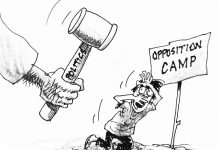This has become a common tale: a newly finished road gave way just months after its inauguration. Cracks had formed like veins across its surface, and soon, a portion collapsed entirely. If this is not a tragic insult to public infrastructure, then what is?
This is not an isolated case. Across provinces and cities, from Northern Luzon to far-flung barangays in Mindanao, one can spot bridges that look like they’re in their final stages of life just months after ribbon-cutting. Drainage systems get clogged with the first rain. Farm-to-market roads are barely passable even on sunny days. All these reveal the same thing: a rotten system that tolerates, and in many cases enables, poor workmanship, the use of substandard materials, and the utter disregard for engineering standards. Government infrastructure, meant to last decades, barely survives a season, and the people, as always, are left to suffer the consequences.
It’s hard not to see the correlation between this kind of decay and the kind of people involved in building them. Contractors win bids not necessarily because they are capable, but because they have connections or know how to play the game. In turn, they cut corners—sand is mixed with more sand, cement is thinned out, steel is downgraded, and laborers are underpaid. The final output is never the structure proposed in the plan. It’s a compromise—an illusion—camouflaged with a fresh coat of paint or a well-placed signboard bearing a politician’s name.
The engineers who ought to safeguard standards often turn a blind eye, as if silence were part of their job description. Some are powerless, others complicit. Inspections become mere formalities. Instead of being the last line of defense against faulty construction, they become enablers of it. It’s as if the entire infrastructure chain—from planning to execution—has been infected by a culture of settling for “pwede na ’yan.” And when mediocrity becomes the standard, collapse is just a matter of time.
Of course, nobody gets jailed when a barangay bridge collapses. No headlines scream for accountability when a newly built seawall crumbles after the first typhoon. Blame is passed around like a hot potato, and then it dies in the pit of bureaucracy. What remains is the crater in the road, the broken slab of concrete, and the danger it poses to every passerby. Meanwhile, the budgets have been released, the commissions pocketed, and the paper trail meticulously sanitized. It’s public funds turned into private gain, written in the language of cracked pavement and rusty reinforcements.
There’s something particularly cruel in the way bad infrastructure harms the poor. They have no choice but to use it every day. Students cross unstable footbridges to attend classes. Farmers must push their carabaos through muddy, barely graveled roads to bring crops to town. Ambulances get delayed by potholes or unfinished highways. Yet it is their taxes, no matter how small, that partly paid for these failures. And it is their votes that gave the officials their power. Ironically, those in government vehicles, cushioned by tinted SUVs and armed with sirens, are least affected by these failures.
But what’s even worse is that this system breeds hopelessness. People stop expecting better. They stop complaining. “Ganyan na talaga ’yan,” they say. It’s a kind of national fatigue—a numbness to institutional failure. And in that numbness lies our greatest tragedy: we stop demanding accountability because we’ve learned not to expect it. Corruption thrives best not in outrage, but in apathy. And when everyone shrugs off a bridge collapse as ordinary, then maybe the collapse we should fear most is not structural, but moral.
It doesn’t have to be this way. Government projects need honest execution. Technical plans must be followed like sacred contracts. Procurement processes should reward competence, not connections. Most of all, those tasked with overseeing public works must be made to walk on the roads they build, use the facilities they fund, and live with the consequences of their choices. Only then might they start building not just with cement and steel, but with conscience.




